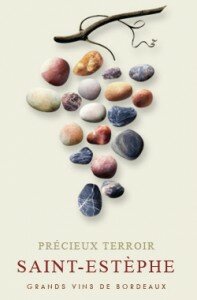How many of you h ave a collection of stones, fossils, shells and pebbles? Quite a few of us are prone to picking up objects from fields and beaches . . . and vineyards.
ave a collection of stones, fossils, shells and pebbles? Quite a few of us are prone to picking up objects from fields and beaches . . . and vineyards.
I came across a conversation on Facebook the other day which was about collecting pebbles from vineyards and it got me thinking.
That people spot interesting finds in vineyards shouldn’t surprise us as the soil is part of the terroir that creates the wine. You only have to look at the logo for Saint Estephe to see the importance of rocks and minerals in Bordelaise vineyards.
It’s said that the Marquis de Ségur, Nicolas Andre (1695-1755) dazzled the court of King Louis XV one day by wearing a coat studded with jewels.
He was known as the Prince of Vines (due to his ownership of Chateaux Lafite, Latour, Mouton, Calon Segur and at one point Pontet Canet).
The King mistook the buttons on the Marquis’ coat for diamonds and commented on their quality – the Marquis replie d to the King that they were not diamonds but cut and polished pebbles from his vineyards.
d to the King that they were not diamonds but cut and polished pebbles from his vineyards.
A few hundred years later another Chateau owner became intrigued with the stones he found on his vineyards. The Vicomte de Roton took over the Premier Cru Sauternes Chateau Rayne Vigneau in 1920 and was an amateur geologist.
He soon realised that his vineyards lay on a unique mineral deposit – amongst the vines were precious and semi-precious stones. The stones are sapphires, chalcedony, agate, topaz, crystal, jasper, amethyst, onyx, carnelian and opals.
The Vicomte collected over 10,000 pieces, a thousand of which have been carved and polished.
He published his findings – which caused somewhat of a stir in the 1930s. Some of his collection at still at the château today but most were dispersed to local museums. As recently as 2001 semi precious stones were found in the rows of vines by several people involved in an investigation.
If you enjoy finding fossils then the little AOC of Sainte Croix du Mont would surprise you as it is endowed with one of nature’s strange wonders. It lies upon a panoramic plateau comprised of vast fossilised oyster beds which give it an exceptional terroir.
Certain châteaux have large, impressive wine cellars which have been hewed directly from this enormous layer of oysters which is several metres thick and the wine caves at the foot of the 12th century Château de Tastes have been adapted as a location for tasting the wines of the appellation.
The legendary oyster bed of Sainte Croix du Mont can be seen along the natural wall found below the church and château. This remarkable geological layer was formed by a tremendous accumulation of shells 20 million years ago.
They are all the same type of oyster: Alectryonia aquitanica and as the shells are closed and densely packed geologists have suggested that it is a fossilised oyster reef.
Generally, when aquatic bivalve molluscs die, the muscles which command the opening and closure of their “cover” slacken and sea currents rapidly separate the two shells.
This was not the case for the majority of the Sainte Croix du Mont oysters, hence the assumption that the oysters actually grew here.
So if you are ever in Bordeaux remember there is more to see in the vineyards than you might think!


